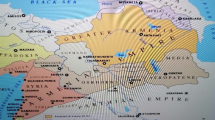Abstract
A series of 18 ceramic samples consisting of pottery shards from ancient vessels dated to the Neolithic period discovered at Oxenbrickel, Sânandrei, Timiş County, Romania (GPS coordinates: 45°51′3.11″N, 21°10′49.32″), have been analyzed by using thermogravimetric, differential thermal analysis (TG/DTA/HF), XRD analysis and Fourier transform infrared spectroscopy. Vessels such as the ones from Oxenbrickel, carrying marks on their bottoms, are to be found among the discoveries of Vinca, Turdaş, Banat, Boian-Giuleşti, Gradešnica, Karanovo IV Kalojanovec, Precucuteni, Hamangia and the Linear Pottery cultures. The results within the present study indicate the technological level observable at Sânandrei falls within the lower range of known firing temperatures, suggesting a different technological approach specific to the Banat Culture or, more likely, an adaptation to local conditions (i.e., available raw materials and fuel sources).












Similar content being viewed by others
References
Roberts JP. Determination of the firing temperature of ancient ceramics by measurement of thermal expansion. Archaeometry. 1963;6:21–5.
Drebushchak VA, Mylnikova LN, Drebushchak TN. Thermoanalytical investigations of ancient ceramics. Review on theory and practice. J Therm Anal Calorim. 2018;133:135–76.
Vlase DS, Vlase TV, Micle D. FT-IR, TG/DTG/DTA-DSC analysis applied on Ottoman pottery discovered following archaeological rescue excavations in Libertăţii Square, Timişoara (2013–’14 Campaign). ArheoVest. 2015;III-2:831–48.
Papadopoulou DN, Lalia-Kantouri M, Kantiranis N, Stratis JA. Thermal, chemical, and mineralogical characterization of ceramic tobacco pipes from Cyprus. J Therm Anal Calorim. 2006;84:39–45.
Pires J, Cruz AJ. Techniques of thermal analysis applied to the study of cultural heritage. J Therm Anal Calorim. 2007;87:411–5.
Artioli G. Scientific methods and cultural heritage: An introduction to the application of materials science to archaeometry and conservation science. Oxford: University Press; 2010.
Stuart BH. Analytical techniques în material conservation. Sidney: Wiley; 2007.
Shoval S, Beck P. Thermo-FTIR spectroscopy analysis as a method of characterizing ancient ceramic technology. J Therm Anal Calorim. 2005;82:609–16.
Seethaa D, Velraj G. Original Characterization and chemometric analysis of ancient pot shards trenched from Arpakkam, Tamil Nadu, India. JART. 2016;14–5:345–53.
Drebushchak VA, Mylnikova LN, Molodin VI. Thermogravimetric investigation of ancient ceramics. J Therm Anal Calorim. 2007;90:73–9.
Traini A, Giannossa LC, Ubbriaco P, Mangone A, De Filippis MD, Laviano R. The reason of the collapse of an ancient kiln in Egnazia from minaralogical and thermal analysis of ceramic finds. J Therm Anal Calorim. 2008;92–1:337–44.
Drebushchak VA, Mylnikova LN, Drebushchak TN. The mass-loss diagram for the ancient ceramics. J Therm Anal Calorim. 2011;104(2):459–66.
Anghel D. Experimental contributions regarding methods of use for the different types of neo-eneolithic pottery firing installations. Apulum. 2003;40:523–33.
Anghel D. Pottery degradation as a result of technological deficiencies. Apulum. 2002;39:597–613.
Alaiba RE. Cucuteni culture pottery. Arheologia Moldovei. 2005;28:57–73.
Lazarovici G, Ionescu C, Gherghari L. Ceramic artefacts from the mid Neolithic fom Transylvania: CCTLNI culture from the Zau site (Mureş county). Angvstia. 2002;7:7–18.
Mihăilescu L. Specifics of pottery from south-western Romania, observed in the pottery centers of Sasca Română, Potoc and Socolari (Caraş-Severin county). Studi şi Comunicări-Etnografie şi Istorie. 1975;I:111–23.
Lazarovici G, Traore F. A pottery firing technique used from prehistory to the present day. An ethno-archaeologicla study. ActaMN 1989–1993; 26–30(I/2): 553–5556.
Orton C, Tyers P, Vince A. Pottery technology. Cambridge: University Press; 1993.
Marian A, Ciută M, Anghel D. Historical considerations regarding a physical chemical analysis of Precriş culture pottery. Sargetia. 2003;31:37–50.
Shoval S, Beck P, Kirsh Y, Levy D, Gaft M, Yadin E. Rehydroxylation of clay minerals and hydration in ancient pottery from the Lasng of Deshur. J Therm Anal Calorim. 1991;37:1579.
Muller CM, Pejcic B, Esteban L, Piane CD, Raven M, Mizaikoff B. Infrared attenuated total reflectance spectroscopy: an innovative strategy for analyzing mineral components in energy relevant systems. Sci Rep. 2014;4:6764.
Shoval S, Beck P. Thermo-FTIR spectroscopy analysis as a method of characterizing ancient ceramic technology. J Therm Anal Calorim. 2005;82:609–16.
Campanella L, Favero G, Flamini P, Tomassetti M. Prehistoric terracottas from the libyan Tadrart Acacus. Thermoanalytical study and characterization. J Therm Anal Calorim. 2003;73(127):142.
Draşovean F. Regarding the relative and absolute chronology of the Neolithic and early Eneolithic in the eastern Carpathian basin. A bayesian approach. Analele Banatului-Arheologie-Istorie. 2014;22:33–77.
Rogozea OC, Dincă R. Vessels with marked bottoms from Sânandrei (Timiş County). Tibiscvm. 2013;3:141–56.
Ion RM, Dumitriu I, Fierascu RC, Ion ML, Pop SF, Radovici C, Bunghez RI, Niculescu VIR. Thermal and mineralogical investigations of historical ceramic. J Therm Anal Calorim. 2011;104:487–93.
Author information
Authors and Affiliations
Corresponding author
Additional information
Publisher's Note
Springer Nature remains neutral with regard to jurisdictional claims in published maps and institutional affiliations.
Rights and permissions
About this article
Cite this article
Vlase, D., Rogozea, O., Moşoiu, C. et al. Thermoanalytical investigations of some ceramics dated from the Neolithic period, discovered at Oxenbrickel, Sânandrei, Romania. J Therm Anal Calorim 138, 2145–2157 (2019). https://doi.org/10.1007/s10973-019-08767-8
Received:
Accepted:
Published:
Issue Date:
DOI: https://doi.org/10.1007/s10973-019-08767-8




